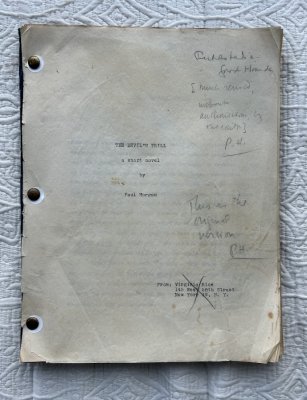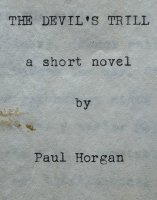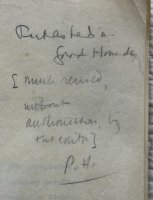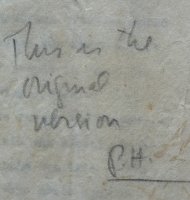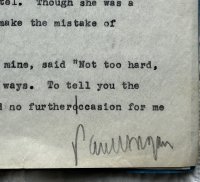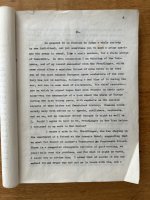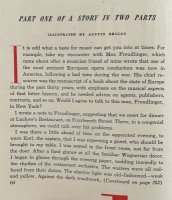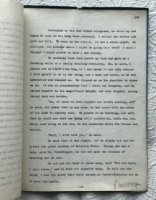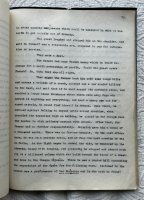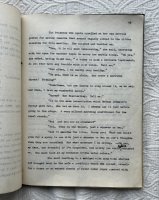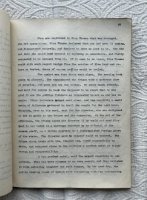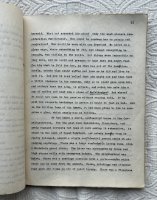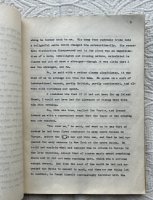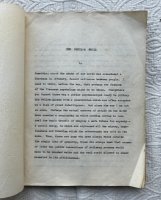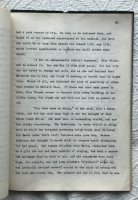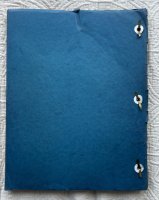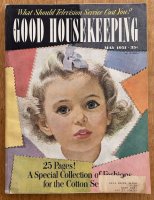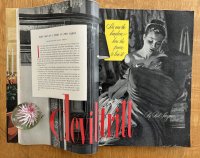Shadowrock Rare Books
Paul HORGAN
Original carbon-copy typescript, signed, of the uncut version of ‘The Devil’s Trill a short novel by Paul Horgan’
the ‘much revised’ version was published in ‘Good Housekeeeping’ Magazine for May and June 1951
$950
Item Details
[USA?], [c.1950-1951?], hole punched
acceptable
Paul HORGAN (1903-1995). Original carbon-copy typescript, signed, of ‘The Devil’s Trill a short novel by Paul Horgan’. [IUSA?: c.1950-1951?]. Quarto, recto only of 107 leaves. Hole-punched and held together by three copper ‘ties’. Condition: some old creasing, hole re-enforcements to first and last leaf. Provenance: probably the author’s retained copy?.
With two penciled notes by Horgan on the covering title page, both initialed, and signed ‘Paul Horgan’ at the foot of the final leaf of text.The penciled notes read ‘Published in Good Housekeeping [much revised, without authorization by the editor] P.H’ and ‘This is the original version P.H.’
The ‘much revised’ version was published in ‘Good Housekeeeping’ Magazine for May and June 1951 (a copy of the May issue is available, and a June issue will be available shortly).
Wikipedia: “Paul George Vincent O'Shaughnessy Horgan (August 1, 1903 – March 8, 1995) was an American writer of historical fiction and non-fiction who mainly wrote about the Southwestern United States. He was the recipient of two Pulitzer Prizes for History.
Historian David McCullough wrote of Horgan in 1989: "With the exception of Wallace Stegner, no living American has so distinguished himself in both fiction and history."
Paul Horgan was born in Buffalo, New York to a Catholic family[2] on August 1, 1903. After his father contracted tuberculosis, the family moved in 1915 to Albuquerque, New Mexico for health reasons. Horgan attended New Mexico Military Institute in Roswell, New Mexico, where he formed a lifelong friendship with classmate and future artist Peter Hurd. Horgan befriended physicist J. Robert Oppenheimer in 1922 during a visit to New Mexico. After finishing high school, Horgan spent a year working for a local newspaper.
In 1923, Horgan enrolled in the Eastman School of Music in Rochester, New York, but dropped out after the first year. He worked for the next three years in Rochester as the set designer for a new opera company being started by tenor Vladimir Rosing. Although Horgan had never designed sets before, he convinced Rosing to give him the job. The fledgling opera company later became the American Opera Company.
In 1924, Horgan returned to Albuquerque. He published his first novel, The Fault of Angels, about his experiences in Rochester in 1923; it won the Harper Prize. He continued to write 17 novels plus other works over the next five decades. Horgan served as president of the American Catholic Historical Association.
During World War II, Horgan moved to Washington, D.C. to serve as the head of the Army Information Branch of the US War Department. He would eventually receive the Legion of Merit and be promoted to lieutenant colonel. He received a Guggenheim Fellowship in 1947. In 1955, Horgan won the Pulitzer Prize for History and the Bancroft Prize for history with Great River: The Rio Grande in North American History, a history of the Rio Grande River in Mexico and the United States.
In 1959, Horgan became a fellow at the Center for Advanced Studies (CAS) at Wesleyan University in Middletown, Connecticut. Over the next 35 years, he would serve as a director of CAS, an adjunct professor of English, and as a professor emeritus and permanent author-in-residence.[8][9][10][7] The author Charles Barber served as a personal assistant to Horgan when Barber was a college student. During this period, Horgan also taught seminars and workshops at Yale University and the University of Iowa.
In 1976, Horgan won the Pulitzer Prize for History for Lamy of Santa Fe (Wesleyan University Press), a biography of Archbishop Jean-Baptiste Lamy.
Horgan published 40 books and received 19 honorary degrees from universities in the United States. He received a papal knighthood from Pope Pius XII. Paul Horgan died at Middlesex County Hospital in Middletown, Connecticut, on March 8, 1995
In 1970, Horgan started his "Heroic Triad" of novels, about the different cultures in the Southwest, with the publication of Whitewater. It was followed by Thin Mountain Air in 1977 and Mexico Bay in 1982.
One of Horgan's most popular works was A Distant Trumpet, a historical novel based on the Apache wars in the Southwest. Horgan's 1972 book Encounters With Stravinsky, a biography of composer Igor Stravinsky, was called "an utterly irresistible book" by New York Times reviewer Simon Karlinsky. In 1960, author Robert Franklin Gish praised Horgan's literary contributions in the monograph Paul Horgan: Yankee Plainsman and a few other works. “ (wikipedia)
Shadowrock Rare Books
Adam Langlands
27 Cleveland St
Lakeville, Ct, 06039
United States
Phone: 8602481547
Cell: 8602481547
Featured Catalogue
Visit Website
Specialities
Nat. History, Bindings, Association copies
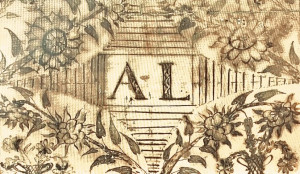
More Information
Booth 34
Shipping and Returns
Shipping will always be at cost. Items are returnable for any reason within a reasonable period of time - we will refund the purchase price, but ask that the buyer pays for the shipping.
Open Times
By AppointmentAdditional Information
Shadowrock Rare Books (https://shadowrockrarebooks.com/): a relatively new multi-faceted book business by a relatively old bookman. Starting in the 1970s, Adam Langlands has worked for most of the great auction houses, and been associated with a number of the greatest dealers. He has examined, researched and catalogued a huge range of books representing many subjects, languages, techniques, dates and price-points: from 'Sky-Hi A trip into space with Terry' (1952, kid's transformational book) to the Fox/Bute copy of Audubon's 'Double-Elephant Folio' (sold at auction for $8,802,500). Inspired by their recent move to a home which previously belonged to both George Simenon (of Maigret fame) and Seymour Hacker (founder of Hacker Art Books), Adam and Susu Langlands have decided to continue the literary connection and set up Shadowrock Rare Books. Today's global online marketplace means that there is a danger that the call of the unique will get drowned out by the cries of the banal: it is the mission of Shadowrock Rare Books to rescue and highlight these gems. Joining Getman’s Virtual Book & Paper Fairs was an obvious next step for us – we have cheered him on from the sidelines from the beginning!
